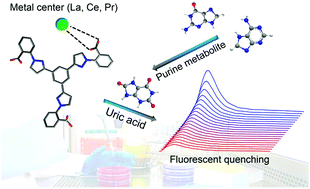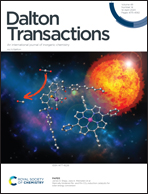Three coordination polymers with regulated coordination interactions as fluorescent sensors for monitoring purine metabolite uric acid†
Abstract
A facile optical sensor for uric acid (UA), an early pathological signature for the metabolic function of humans, was developed based on water-stable coordination polymers (CPs). Herein, three new isostructural fluorescent CPs, [Ln(TCPB)(DMF)3]n (Ln = La, CP 1; Ce, CP 2 and Pr, CP 3; H3TCPB = 1,3,5-tris(1-(2-carboxyphenyl)-1H-pyrazol-3-yl)benzene), with various metal ions were solvothermally synthesized. Significantly, by regulating the metal–organic coordination interactions, the fabricated CP 3 can quantitatively recognize UA with higher sensitivity compared with CP 1 and CP 2. The mechanism for the sensing properties further demonstrates the best performance of CP 3 and the excellent selectivity for UA monitoring. This work represents the strategy of designing fluorescent CP sensors to determine UA and provides a convenient approach for developing analysis platforms for the assessment of related disease progress and human health monitoring.



 Please wait while we load your content...
Please wait while we load your content...